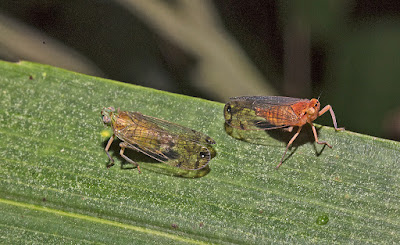Many varieties of tropical fruit can be seen there. A number of large Raintrees and fig trees adorn the site.
Sunset at Sugarworld B. Richardson photo
About 100 people attended the night walk. We were expecting to see Fruit Bats in the trees and other mammals but it was not to be. A few Thick-knees Curlews, were seen along the margins of the park. But insects were, surprisingly, in sparse numbers on the light sheets. We found a number of interesting species by diligently searching foliage and leaf litter. This was a challenge but everyone opened their eyes and found a variety of insects and spiders. Most people were not accustomed to searching for insects after dark.
Click on the photos to enlarge
Click on the photos to enlarge
The most interesting find was a mass of sleeping bees.
There were thousands of them assembled on leaves of various trees from about 2-3 m from the ground.
Ken Walker, Melbourne Museum, has identified the bees as members of the family Halictidae, Homalictus sp. but probably blackburni. He also notes that in the bottom photo all the bees are males and they are all aligned in the same direction for some reason.
Bees were not the only insects found in groups. This group of Assassin Bugs (below) was clustered on a tree trunk. Close examination reveals that some individuals are moulting on their way to adulthood.
Assassin Bugs prey on other insects. Here the mass is probably conveying more safety to the group than one bug alone. Also note that they use the cover of darkness to moult. By morning, they will have hardened up enough to resume their predatory ways.
Other insects seen
Courting fulgoroids on a palm frondA young cricket, Cardiodactylus novaeguineae. This cricket will require several more weeks to develop into an adult. It is a large species that sings day and night and is easily observed on shrubby vegetation.
Carbrunneria maxi. This cockroach was very common in leaf litter and could be seen after dark on leaf surfaces where it gleans particles of food that rain down from the canopy. It is a native cockroach that could not survive for long in the house.
The Surinam Cockroach, Pycnoscelus surinamensis. This is an introduced cockroach that is parthenogenetic, that is, females can produce young whether they mate or not. Females of this species produce live young. Males are rarely found. It is a useful species in culture since live births can be observed. This cockroach is pan-tropical in its distribution. It lives in leaf litter, potted plants and in leaves that accumulate in gutters. It does not live in houses. It has ben implicated in destroying some vegetables and as an intermediate host of parasitic worms that can infest poultry.
One of the many varieties of tropical fruit at Sugarworld. It is being visited by a last instar (subadult) nymph of a beautiful Raspy Cricket, Xanthogryllacris punctipennis. Note the sleeping bees on adjacent leaves and their orientation.
One of the few spectacular insects attracted to our lights was the scarab, Mycterophallus duboulayi, is normally day-flying and feeds on flowers. If the diurnal beetles are resting in the vicinity of lights, they often are attracted.




























No comments:
Post a Comment